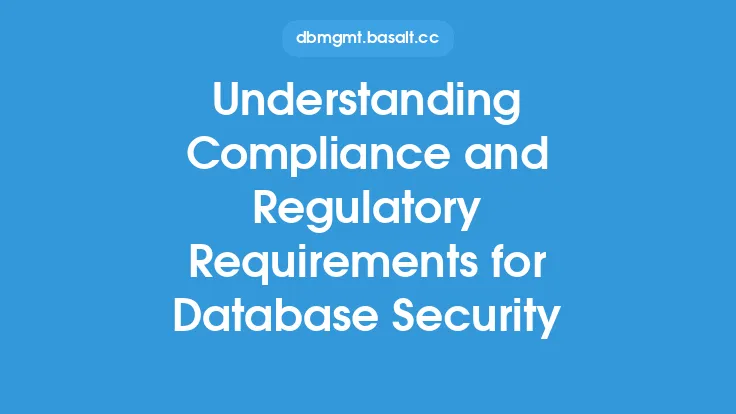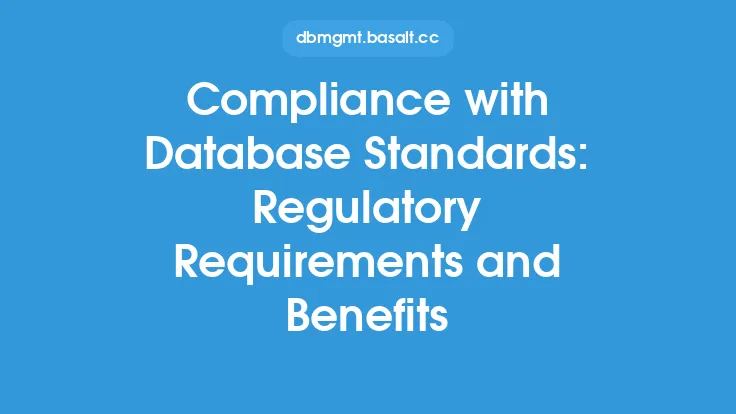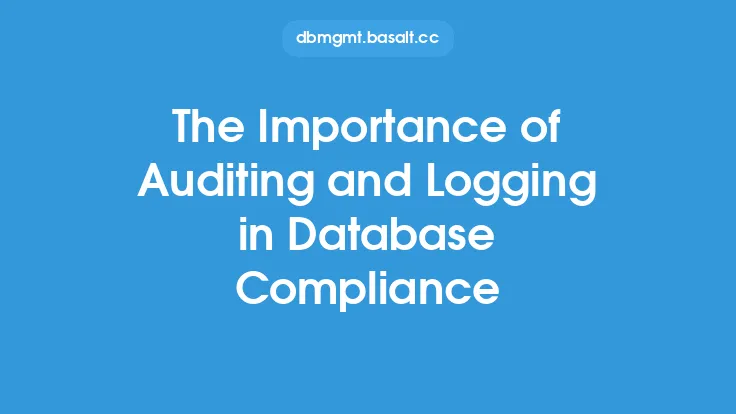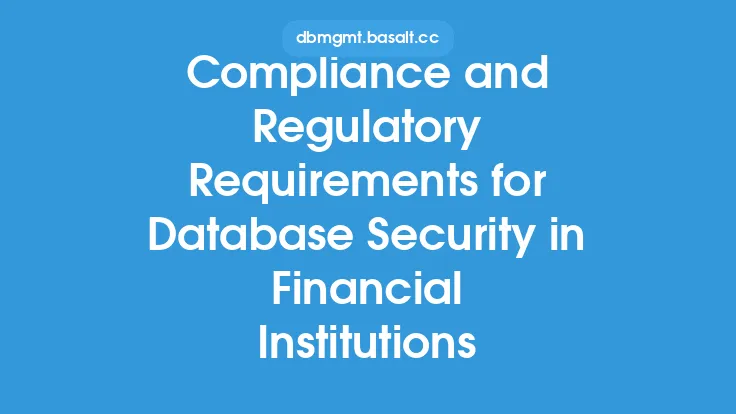In today's digital landscape, databases are the backbone of any organization, storing sensitive information that is crucial to business operations. As such, ensuring the security and integrity of databases is paramount. One critical aspect of database security is auditing and compliance, which involves monitoring and tracking all activities within the database to meet regulatory requirements. This is essential for maintaining the trust of customers, protecting against data breaches, and avoiding costly fines and penalties.
Introduction to Database Auditing and Compliance
Database auditing and compliance involve the process of monitoring, tracking, and analyzing all activities within a database to ensure that they meet regulatory requirements. This includes tracking changes to database structures, monitoring user activity, and detecting potential security threats. The goal of database auditing and compliance is to provide a clear and transparent record of all database activities, which can be used to demonstrate compliance with regulatory requirements and to investigate any security incidents.
Regulatory Requirements for Database Auditing and Compliance
There are several regulatory requirements that organizations must comply with when it comes to database auditing and compliance. These include the Payment Card Industry Data Security Standard (PCI DSS), the Health Insurance Portability and Accountability Act (HIPAA), the Sarbanes-Oxley Act (SOX), and the General Data Protection Regulation (GDPR). Each of these regulations has specific requirements for database auditing and compliance, such as tracking access to sensitive data, monitoring changes to database structures, and detecting potential security threats.
Benefits of Database Auditing and Compliance
Database auditing and compliance provide several benefits to organizations, including improved security, reduced risk, and increased transparency. By monitoring and tracking all activities within the database, organizations can detect potential security threats and prevent data breaches. Additionally, database auditing and compliance can help organizations to demonstrate compliance with regulatory requirements, which can reduce the risk of costly fines and penalties. Finally, database auditing and compliance can provide a clear and transparent record of all database activities, which can be used to improve database performance and optimize database operations.
Best Practices for Database Auditing and Compliance
There are several best practices that organizations can follow to ensure effective database auditing and compliance. These include implementing a robust auditing and logging mechanism, monitoring and analyzing audit logs regularly, and using automated tools to detect potential security threats. Additionally, organizations should ensure that all database activities are tracked and monitored, including changes to database structures, user activity, and system changes. Finally, organizations should regularly review and update their database auditing and compliance policies to ensure that they remain effective and compliant with regulatory requirements.
Tools and Technologies for Database Auditing and Compliance
There are several tools and technologies that organizations can use to support database auditing and compliance. These include database auditing software, log analysis tools, and security information and event management (SIEM) systems. Database auditing software can be used to track and monitor all database activities, while log analysis tools can be used to analyze and interpret audit logs. SIEM systems can be used to detect potential security threats and provide real-time alerts and notifications. Additionally, organizations can use cloud-based services, such as cloud auditing and compliance platforms, to support database auditing and compliance.
Challenges and Limitations of Database Auditing and Compliance
Despite the importance of database auditing and compliance, there are several challenges and limitations that organizations may face. These include the complexity of database systems, the volume of audit data, and the lack of skilled personnel. Additionally, organizations may face challenges in implementing and maintaining effective database auditing and compliance policies, particularly in large and complex database environments. Finally, organizations may face limitations in terms of budget and resources, which can make it difficult to implement and maintain effective database auditing and compliance mechanisms.
Future of Database Auditing and Compliance
The future of database auditing and compliance is likely to be shaped by several trends and technologies, including cloud computing, artificial intelligence, and machine learning. Cloud computing is likely to play a major role in database auditing and compliance, as more organizations move their databases to the cloud. Artificial intelligence and machine learning can be used to improve the accuracy and effectiveness of database auditing and compliance, particularly in terms of detecting potential security threats. Additionally, the use of automation and orchestration tools is likely to increase, as organizations seek to streamline and simplify their database auditing and compliance processes.
Conclusion
In conclusion, database auditing and compliance are critical components of database security, and are essential for maintaining the trust of customers, protecting against data breaches, and avoiding costly fines and penalties. By understanding the regulatory requirements for database auditing and compliance, and by following best practices and using effective tools and technologies, organizations can ensure that their databases are secure, compliant, and well-managed. As the landscape of database security continues to evolve, it is likely that database auditing and compliance will play an increasingly important role in protecting sensitive data and preventing security threats.





